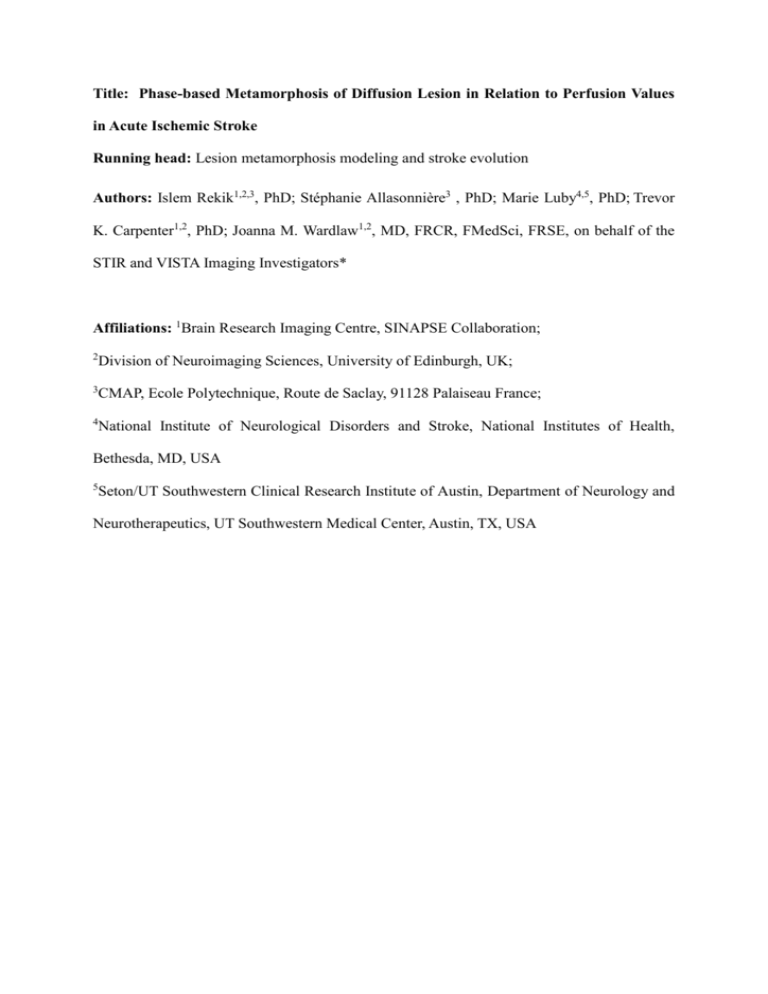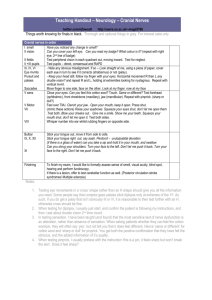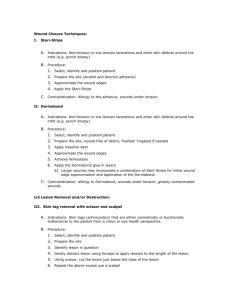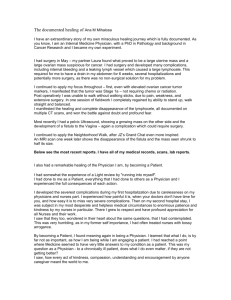Rekik et al. NICL manuscript 2015
advertisement

Title: Phase-based Metamorphosis of Diffusion Lesion in Relation to Perfusion Values
in Acute Ischemic Stroke
Running head: Lesion metamorphosis modeling and stroke evolution
Authors: Islem Rekik1,2,3, PhD; Stéphanie Allasonnière3 , PhD; Marie Luby4,5, PhD; Trevor
K. Carpenter1,2, PhD; Joanna M. Wardlaw1,2, MD, FRCR, FMedSci, FRSE, on behalf of the
STIR and VISTA Imaging Investigators*
Affiliations: 1Brain Research Imaging Centre, SINAPSE Collaboration;
2
Division of Neuroimaging Sciences, University of Edinburgh, UK;
3
CMAP, Ecole Polytechnique, Route de Saclay, 91128 Palaiseau France;
4
National Institute of Neurological Disorders and Stroke, National Institutes of Health,
Bethesda, MD, USA
5
Seton/UT Southwestern Clinical Research Institute of Austin, Department of Neurology and
Neurotherapeutics, UT Southwestern Medical Center, Austin, TX, USA
Abstract
Examining the dynamics of stroke ischemia is limited by the standard use of 2D-volume or
voxel-based analysis techniques. Recently developed spa- tiotemporal models such as the 4D
metamorphosis model showed promise for capturing ischemia dynamics. We used a 4D
metamorphosis model to evalu- ate acute ischemic stroke lesion morphology from the acute
diffusion-weighted imaging (DWI) to final T2-weighted imaging (T2-w). In 20 representative
patients, we metamorphosed the acute lesion to subacute lesion to final infarct. From the
DWI lesion deformation maps we identified dynamic lesion areas and examined their
association with perfusion values inside and around the lesion edges, blinded to reperfusion
status. We then tested the model in ten independent patients from the STroke Imaging
Repository (STIR). Per- fusion values varied widely between and within patients, and were
similar in contracting and expanding DWI areas in many patients in both datasets. In 25% of
patients, the perfusion values were higher in DWI-contracting than DWI-expanding areas. A
similar wide range of perfusion values and ongoing expansion and contraction of the DWI
lesion were seen subacutely. There was more DWI contraction and less expansion in patients
who received thrombolysis, although with widely ranging perfusion values that did not differ.
4D metamorphosis modeling shows promise as a method to improve use of multimodal
imaging to understand the evolution of acute ischemic tissue towards its fate.
Key words: metamorphosis; ischemic stroke; lesion evolution; diffusion imaging; perfusion
imaging, magnetic resonance imaging; diffusion imaging
1. Introduction
The change in ischemic stroke lesions from acute presentation to final tissue damage is
highly variable between individual patients as seen on magnetic resonance diffusion and
perfusion imaging. Following the occlusion of a cerebral artery, ischemic tissue damage is
seen as hyperintense on diffusion- weighted imaging (DWI) often within a larger area of
hypoperfused at-risk, but potentially reversible tissue ischemia, detectable on perfusionweighted imaging (PWI). Thereafter the ischemic tissue may grow or diminish depending on
known and unknown factors. Subsequent growth of the lesion core, considered to be
represented by DWI, is generally attributed to persistently reduced perfusion values around
the core, whereas recovery of ischemic tissue is generally attributed to improvement in
perfusion (Wardlaw, 2010).
Many imaging studies have investigated stroke lesion evolution mainly using 2D lesion
volume or voxel-based analyses, but these may not capture the full spatiotemporal dynamics
of perfusion and diffusion lesions as they may under-sample information about the location,
direction or magnitude of the lesion dynamics in space and time (Rekik et al., 2012).
Recently, we applied 4D shape deformation modeling methods to examine the highly
contracting and expanding areas in DWI and PWI lesions (Rekik et al., 2013, 2014).
Of theses methods, the metamorphosis model (Trouv ́e and Younes, 2005; Younes, 2010;
Rekik et al., 2014) handled both multi-component and solitary lesions and incorporated
image intensity values from different sequences, and demonstrated elegance and accuracy of
deforming the source image into a subsequent image, while tracking, point by point, a) the
image intensity values inside and outside the lesion edges and b) the velocity of lesion deformation between timepoints. Notably, the proposed metamorphosis model in (Rekik et al.,
2014) could follow ischemic stroke lesion change in perfusion weighted imaging from the
acute to final infarct. It enabled to explore the perfusion dynamics in ischemic stroke and
their relation to final T2-w lesion outcome (at ≥1month). However, the role of diffusion
weighted imaging, which is fundamental to understanding stroke dynamics, was overlooked.
In this paper, we aim to investigate diffusion lesion local dynamic changes in relation to
perfusion values in the affected hemisphere.
By applying this model to longitudinal images, the present study aims to: (1) model changes
in the acute ischemic DWI lesion from the acute timepoint into the final infarct lesion, in both
solitary and multi-component lesions; and (2) extract measurements of the most dynamic
parts of the lesion to see the most rapid or largest areas of the DWI lesion
expansion/contraction areas in relation to PWI values and clinical features such as stroke
severity. We tested our model on stroke imaging data acquired in an observational study in
one center (Rivers et al., 2006; Kane et al., 2007) and then validated the model in multicentre
data obtained from STIR (Ali et al., 2007).
2. Materials and Methods
2.1 Patient selection:
Development dataset: We first applied the metamorphosis model to 20 representative patients
from a prospective observational study of MRI in hyperacute stroke.7,8 Patients were first
imaged <6 hours of stroke and represented a typical range of stroke severities (NIHSS,
median = 10, IQR: 6-14), ages (74.9±9.2years), acute DWI lesion volumes (34.6±32.2cm3)
and mean transit time (MTT) volumes (126.6±102.2cm3). None of the 20 patients received rtPA treatment, thus they represent the natural history of stroke lesion evolution, including any
effects of spontaneous reperfusion. We included patients who had DWI images at acute
(~5hrs) and subacute (~5±1days) timepoints after stroke, a perfusion mean transit time
(MTT) map at least at the acute timepoint, and T2-w lesion at ≥1month after stroke. All
patients had an MTT lesion at the first timepoint but only 12 had an MTT lesion visible at the
second timepoint. Twelve patients had multi-component DWI/MTT lesions and eight had
solitary lesions.
Exploratory dataset: we selected from STIR9 the first 10 of 290 potential cases with three
MRI scans at acute (<6hrs), subacute (5days) and final (≥1month). The first 10 patients that
met the study criteria (age 59.6±16.4years, median admission NIHSS of 7 (IQR: 5-12)) had
all received standard IV tPA thrombolysis. All had perfusion imaging <6hrs but perfusion
imaging was included per protocol at subacute (5 days).
2.2 MRI Pre-Processing:
We used the MTT perfusion map as it is easily obtained and generally shows the PWI lesion
as large.7,8 The modeling was blind to all clinical data and imaging values. Arterial
recanalization status and collaterals were not taken into account in the modeling as
angiographic data were not available for all patients. STIR exploratory data were processed
identically to the derivation data unless stated otherwise. Full details of image acquisition and
processing were described previously.7,10 We obtained MTT areas from the contralateral
hemisphere by mirror reflection of the MTT lesion to the unaffected hemisphere. For each
patient, we generated relative MTT (rMTT) lesion maps by dividing the value of each lesion
voxel by the mean perfusion value of the contralateral MTT values. The resulting intensity
‘rMTT’ has no unit. An expert radiologist visually checked that tissue swelling did not distort
the DWI lesion boundary.
2.3 Two-image based metamorphosis model:
In our previous work (Rekik et al., 2014), we extended the image-to-image metamorphosis
into a spatiotemporal metamorphosis that exactly fits the baseline image to subsequent
observations in an ordered set I = {I0, I1, . . . , IT } images, which we applied to perfusion data
in acute stroke. This model registers one source image to a target image while estimating two
op- timal evolution paths linking these images: (1) a geometric path encoding the smooth
velocity of the deformation of one image into another, and (2) a photometric path
representing the variation in image intensity. Both paths characterize the dynamics of the
image metamorphosis from the source to the target image in small discrete time and space
intervals.
Basically, a baseline image 𝐼0 morphs under the action of a velocity vector field 𝑣𝑡 that
advects the scalar intensity field 𝐼𝑡 (i.e. time-evolving image intensity) Trouve and Younes
(2005). Solving the advection equation with a residual allows to estimate both image
intensity evolution and the velocity at which it moves.
We estimated the optimal metamorphosis path (𝐼𝑡 , 𝑣𝑡 ) starting at 𝐼0 , while constraining it to
smoothly and exactly go through any available intermediate observation, till reaching the
final observation 𝐼𝑇 . This was achieved through minimizing the following cost functional 𝑈
using a standard alternating steepest gradient descent algorithm Rekik et al. (2014):
2
𝑇
𝑈(𝐼, 𝑣) = ∫
|𝑣𝑡 |2𝑉 𝑑𝑡
0
1 𝑑𝐼(𝑡)
+ 2 |
+ 𝛻𝐼𝑡 . 𝑣𝑡 | 𝑑𝑡
𝜎
𝑑𝑡
𝐿2
𝜎 weighs the trade-off between the deformation smoothness (first term)
and fidelity-to-data (second term). The term 𝛻𝐼𝑡 . 𝑣𝑡 represents the spatial variation of the
moving image 𝐼𝑡 in the direction 𝑣𝑡 . Furthermore, the moving intensity field 𝐼𝑡 is defined
under the action of the diffeomorphism (invertible smooth mapping) 𝜙𝑡 on a baseline image
𝐼0 : 𝐼𝑡 = 𝜙𝑡 . 𝐼0 . We associated to the action 𝜙 a velocity 𝑣 that satisfies the flow equation
rooted in the in-vogue large deformation diffeomorphic metric (LDDMM) framework
(Trouve, 1998):
𝑑𝜙𝑡
= 𝑣(𝜙𝑡 (𝑥)), 𝑡 ∈ [0, 𝑇]
{ 𝑑𝑡
𝜙0 (𝑥) = 𝑥
In the present study, we used the estimated velocity vector field 𝑣𝑡 to estimate the total DWI
lesion deformation map in two phases:
1) In the first phase, we morphed acute (< 6hr) DWI lesion to subacute (∼ 5d) DWI lesion in
20 patients; and
2) In the second phase, we morphed the subacute (∼ 5d) DWI lesion into the final T2-w (≥1
month) in the 12/20 patients with subacute perfusion imaging. Retaining these two distinct
phases, ‘acute to subacute’ and ‘sub- acute to final’, facilitated testing of acute separately
from subacute clinical information against the lesion parameters.
2.4 Extracting highly dynamic regions of DWI lesion:
For both phases, in each patient, we generated a total 3D lesion deformation map, computed
as the squared sum of the estimated speed along the metamorphosis path, and identified
contracting and expanding DWI regions (as the ‘negative’ and ‘positive’ deformation values
respectively) during each phase (Figure 1). In the exploratory dataset (STIR), we were only
able to estimate the acute to subacute phases since subacute perfusion imaging was not
available for all 10 patients. We then automatically thresholded the two total metamorphosis
deformation maps generated for the acute-subacute and subacute-late phases of DWI lesion
evolution to compute the proportion by volume of the total DWI lesion boundary that was
rapidly contracting or expanding for the acute-subacute and subacute-late phases.
2.5 rMTT values relation to DWI lesion dynamics:
For each patient, for both phases, for every rMTT voxel value within the acute perfusion
image we computed the mean amount of DWI lesion contraction or expansion. We then
plotted the acute rMTT values against their corresponding mean DWI contraction or
expansion magnitudes (Figure 2). In most cases, both resulting rMTT distributions were
Gaussian. Therefore, we used Gaussian least squares fit to approximate the relation between
acute rMTT values and the mean amounts of DWI lesion deformation: one for contraction
(purple curve in Figure 2) and one for expansion (pink curve in Figure 2). For phase one, the
Gaussian fitting root-mean-square deviation (RMSE) reached 0.0035 ± 0.0042 for
contraction and 0.006 ± 0.014 for expansion, noting that when the fitting is exact RMSE = 0
(no residuals or perfect test). For phase two, the data also best fitted a Gaussian distribution
(RMSE = 0.0029 ± 0.0032 for contraction and 0.0039 ± 0.0058 for expansion). These
Gaussian curves allowed us to estimate the rMTT values associated with rapidly expanding
or contracting DWI regions– along with a confidence interval around these peak values: the
upper bound represents the mean of the Gaussian curve minus its standard deviation and the
lower bound represents the mean of the Gaussian curve plus its standard deviation.
3. Results
Derivation dataset lesion metamorphosis and perfusion values: acute to subacute phases:
The model showed that the mean rMTT values in areas of DWI expansion across patients
(mean 0.8±0.82SD, maximum 3.18) were similar to mean rMTT values in areas of DWI
contraction (mean 0.74±0.63SD, maximum 2.17), Table 1. In general, the range of rMTT
values in all parts of the DWI lesion boundary was wide such that in most of the 20
derivation dataset patients (15/20), the rMTT values in DWI lesion areas that were
contracting were nearly identical to the values in DWI areas that were expanding (correlation
coefficient r=0.86, p=0.8), shown as the overlap of the red and blue vertical bars in Figure 3.
Only in 5/20 patients (25%) were the blue and red vertical bars distinct, indicating that acute
perfusion was clearly better in areas of DWI contraction than in areas of DWI expansion
(Figure 3). In some patients (7/20 in Figure 3), the red bars extended beyond the blue bars
indicating that perfusion values associated with most rapidly expanding DWI areas
encompassed a wider range of MTT perfusion values than in rapidly contracting DWI areas.
Lesion metamorphosis and perfusion values: subacute to final phase:
A similar general pattern of rMTT values was seen in the 12 patients who had rMTT data
available from the subacute to final phases (~5d to >1month, Table 1, Figure 4). The rMTT
values were very similar in DWI expanding and contracting areas in most patients (r=0.91,
p=0.8). In 3/12 patients (25%), subacute rMTT values in DWI contracting areas were higher
than in DWI lesion expansion areas indicating better perfusion in contracting areas. Table 1
also indicates that a) DWI lesions were still expanding into some areas and regressing in
others and b) perfusion values remain very variable during the subacute to final phase.
DWI dynamic evolution features:
We assessed the proportion of the DWI lesion that highly contracted or expanded at each
phase (Table 1). During both phases, 11/20 (55%) patients had more highly expanding than
contracting areas, although the difference in median volumetric proportions of the DWI
lesion was not significant (p=0.62 for acute-subacute and p=0.13 for subacute-final phases).
Also some DWI lesions continued to expand rapidly in some areas and to contract in others
in quite similar proportions, highlighting the dynamism of acute and subacute stroke lesions
(Table 1).
DWI metamorphosis, perfusion and clinical features:
During the acute-subacute phase, there was no association between acute NIHSS and rMTT
values found in expanding (r=0.11, p=0.63) or contracting (r=0.06, p=0.77) DWI lesion areas.
Similarly, during subacute-final phase, there was no association between admission NIHSS
and rMTT values found in contracting (r=0.007, p=0.99) or expanding (r=-0.021, p=0.95)
DWI lesion areas. We also investigated the association between the proportion of the DWI
lesion volume that was highly contracting or expanding during acute-subacute and subacutefinal phases and various clinical factors (acute NIHSS, acute MTT volume, acute DWI
volume), but found no significant correlations. For all, we obtained: (i) acute-subacute phase:
contraction r=0.082, p=0.731; expansion r=0.258, p=0.271 and (ii) subacute-final phase:
contraction r=0.181, p=0.444; expansion r=0.255, p=0.277.
Evaluation of the model in the exploratory dataset from STIR:
In the 10 STIR9 stroke patients, the rMTT values in contracting or expanding DWI lesion
areas were highly positively correlated (r=0.98, p=0.0001) (Table 1, Figure 5). However, a
larger proportion of the DWI lesion was contracting (median: 4.16% of the acute DWI lesion
volume), and a smaller proportion expanding (median: 1.81% of the acute DW lesion
volume) in the STIR exploratory dataset than in the derivation dataset (median: 3.39%
contracting, median: 4.38% expanding), possibly reflecting the effects of thrombolysis in the
STIR patients.
5. Discussion
We show that a dynamic metamorphosis model (Rekik et al., 2014; Trouve and Younes, 2005;
Younes, 2010) has promise for modeling ischemic stroke lesion evolution using acute and
subacute DWI, rMTT and final T2-w images in space and time. This enabled us to visualize
and extract dynamic features of the ischemic lesion, such as the magnitude of contraction and
expansion of the DWI lesion as a function of lesion volume and in relation to rMTT values.
In our heterogeneous, small, but representative samples, we found that (i) dynamic changes
in the DWI lesion were not confined to the first few hours after stroke but continued for days
or weeks, accompanied by wide-ranging perfusion values; (ii) a similar wide range of
perfusion values were associ- ated with large DWI lesion deformations from acute to
subacute timepoints within individual patients, meaning that in most patients (75%) the
rMTT values covered the same range in contracting and expanding DWI regions; in about
25% of patients in both datasets, the perfusion values were higher in contracting than
expanding DWI regions; (iii) there was large variation between patients in the perfusion
values in DWI lesion areas that undergo the largest deformations, even where there was
greater DWI contraction af- ter thrombolysis; and (iv) there was large between-patient
variation in the amount of DWI lesion change in acute to final phases after stroke, although
we found more DWI lesion contraction in patients in STIR who received thrombolytic
treatment than in the observational study where no patients received thrombolysis.
Our findings suggest that PWI values are more heterogeneous than has been suggested using
average values obtained from DWI and PWI data obtained from regions of interest at
individual timepoints (Dani et al., 2012). The variation is consistent with the wide variation
in perfusion levels found in the literature (Kane et al., 2007; Dani et al., 2012), and with the
recent concept of perfusion strata (or confidence intervals) as a biologically plausible
representation of infarct risk maps (Nagakane et al., 2012). The absence of a clear difference
between perfusion values in expanding versus contracting DWI lesion areas in 75% of our
small but representative group of 30 patients points to a need to identify other factors that
influence DWI lesion progression or reversal. The influence of lesion swelling, perfusion
heterogeneity at capillary level (Ostergaard et al., 2013), collaterals, completeness of arterial
occlusion at the primary occlusion site (Rekik et al., 2012; Phan et al., 2009) and perfusion
levels assessed with other perfusion parameters, should be examined in future studies.
Since our sample lacked statistical power due to its small size, the method should be applied
in larger datasets of stroke patients with varied lesions, timepoints, treatments and outcomes
and with other perfusion parameters. Although we did not explicitly model the effect of
arterial patency, the per- fusion being delivered to the tissues was captured in the voxel-level
rMTT values. These observations of stroke lesion ‘natural history’ in the 20-patient derivation
dataset and ‘thrombolysis-enhanced’ in the 10 patient exploratory dataset, highlight the
complexity and the variability of ischemic stroke lesion dynamics (Scalzo et al., 2013).
Further refinement of the 4D model and inclusion of other factors such as recanalization and
lesion swelling would further advance our understanding of these dynamics, explain
inconsistencies between past studies Dani et al. (2012), and provide a more nuanced
understanding of how perfusion values influence DWI lesion progression to different fates.
6. Conclusion
In this work, we used the metamorphosis model that tracks both intensity and shape changes
in evolving images to examine the influence of local voxel- wise perfusion values on
ischemic lesion core dynamics (i.e. contraction and expansion) visible on diffusion weighted
imaging. The wide range of perfusion values and lack of difference between contracting and
expanding areas emphasizes the very dynamic nature of stroke and explains difficulty in
using threshold values to discriminate tissues states. Indeed, the noted observations add up to
the growing evidence of the wide spectrum of heterogeneous perfusion values, and question
the true extent of their contribution into determining final infarcted tissue boundary. As noted
in (Rekik et al., 2012), we believe that applying highly advanced, accurate and robust
medical image analysis methods will help neurologists and stroke researchers converge to a
unified vision of stroke dynamics and what truly drives tissue death. More clinical factors
remain broadly unknown and others can be included into honing these models in future
studies (e.g., swelling or spontaneous reperfusion). Patient-specific dynamic modeling could
be of potential use in future larger studies to determine what factors influence stroke lesion
evolution and responses to treatment in individual patients. Such advances are necessary to
determine in future which patients are most suited to which treatments – i.e. personalized
medicine.
Sources of Funding:
This study was funded by the Scottish Funding Council through the Scottish Imaging
Network,
A
Platform
for
Scientific
Excellence
(SINAPSE)
Collaboration
(http://www.sinapse.ac.uk/), the Centre for Clinical Brain Sciences, the Tony Watson Bequest
and a Scottish Overseas Research Award from the University of Edinburgh (PhD for Islem
Rekik), the Scottish Funding Council SINAPSE Collaboration (to Prof. Joanna Wardlaw), the
Cohen Charitable Trust (to Dr. Trevor Carpenter and Dr Islem Rekik), and the Chief Scientist
Office of the Scottish Government.
This work was also supported by Seton/UT Southwestern Clinical Research Institute of
Austin, Department of Neurology and Neurotherapeutics, UT Southwestern Medical Center,
Austin, TX, USA and the National Institute of Neurological Disorders and Stroke (NINDS),
National Institutes of Health (NIH), Bethesda, MD, USA.
Disclosure/Conflict of Interest
The authors declare no conflict of interest.
References
Ali, M., Bath, P., Curram, J., Davis, S., Diener, H., Donnan, G., Fisher, M., Gregson, B.,
Grotta, J., Hacke, W., Hennerici, M., Hommel, M., Kaste, M., Marler, J., Sacco, R., Teal, P.,
Wahlgren, N., Warach, S., Weir, C., Lees, K., 2007. The virtual international stroke trials
archive. Stroke 38, 1905–1910.
Dani, K., Thomas, R., Chappell, F., Shuler, K., Muir, K., Wardlaw, J., 2012. Systematic
review of perfusion imaging with computed tomography and magnetic resonance in acute
ischemic stroke: heterogeneity of acquisition and postprocessing parameters: a translational
medicine research collabo- ration multicentre acute stroke imaging study. Stroke 43, 563–
566.
Kane, I., Carpenter, T., Chappell, F., Rivers, C., Armitage, P., Sandercock, P., Wardlaw, J.,
2007. Comparison of 10 different magnetic resonance perfusion imaging processing methods
in acute ischemic stroke: effect on lesion size, proportion of patients with diffusion/perfusion
mismatch, clin- ical scores, and radiologic outcomes. Stroke 38, 3158–3164.
Luby, M., Bykowski, J., Schellinger, P., Merino, J., Warach, S., 2006. Intra- and interrater
reliability of ischemic lesion volume measurements on diffusion-weighted, mean transit time
and fluid-attenuated inversion recovery mri. Stroke 37, 2951–2956.
Nagakane, Y., Christensen, S., Ogata, T., Churilov, L., Ma, H., Parsons, M., Desmond, P.,
Levi, C., Butcher, K., Davis, S., Donnan, G., 2012. Moving beyond a single perfusion
threshold to define penumbra: a novel probabilistic mismatch definition. Stroke 43, 1548–
1555.
Ostergaard, L., Jespersen, S., Mouridsen, K., Mikkelsen, I., Jonsdottir, K., Tietze, A., Blicher,
J., Aamand, R., Hjort, N., Iversen, N., Cai, C., Hougaard, K., Simonsen, C., WeitzelMudersbach, P.V., Modrau, B., Na- genthiraja, K., Ribe, L.R., Hansen, M., Bekke, S.,
Dahlman, M., Puig, J., Pedraza, S., Serena, J., Cho, T., Siemonsen, S., Thomalla, G., Fiehler,
J., Nighoghossian, N., Andersen, G., 2013. The role of the cerebral capillaries in acute
ischemic stroke: the extended penumbra model. J Cereb Blood Flow Metab 33, 635–648.
Phan, T., Donnan, G., Srikanth, V., Chen, J., Reutens, D., 2009. Hetero- geneity in infarct
patterns and clinical outcomes following internal carotid artery occlusion. Arch Neurol 66,
1523–1528.
Rekik, I., Allassonniere, S., Carpenter, T., Wardlaw, J., 2012. Medical image analysis
methods in MR/CT-imaged acute-subacute ischemic stroke lesion: Segmentation, prediction
and insights into dynamic evolution simulation models. a critical appraisal. Neuroimage Clin
1, 164–178.
Rekik, I., Allassonniere, S., Carpenter, T., Wardlaw, J., 2014. Using lon- gitudinal
metamorphosis to examine ischemic stroke lesion dynamics on perfusion-weighted images
and in relation to final outcome on T2-w im- ages. Neuroimage Clin 5, 332–340.
Rekik, I., Allassonniere, S., Durrleman, S., Carpenter, T., Wardlaw, J., 2013. Spatiotemporal
dynamic simulation of acute perfusion/diffusion ischemic stroke lesions evolution: a pilot
study derived from longitudinal MR pa- tient data. Comput Math Methods Med 2013,
283593.
Rivers, C., Wardlaw, J., Armitage, P., Bastin, M., Carpenter, T., Cvoro, V., Dennis, P.H.,
2006. Do acute diffusion- and perfusion-weighted MRI lesions identify final infarct volume
in ischemic stroke? Stroke 37, 98–104.
Scalzo, F., Alger, J., Hu, X., Saver, J., Dani, K., Muir, K., Demchuk, A., Coutts, S., Luby,
M., Warach, S., Liebeskind, D., 2013. Multi-center pre- diction of hemorrhagic
transformation in acute ischemic stroke using per- meability imaging features. Magn Reson
Imaging 31, 961–969.
Trouve, A., 1998. Diffeomorphisms groups and pattern matching in image analysis.
International Journal of Computer Vision 28, 213–221.
Trouve A., Younes, L., 2005. Metamorphoses through lie group action. Foundations of
Computational Mathematics 5, 173–198.
Wardlaw, J., 2010. Neuroimaging in acute ischaemic stroke: insights into unanswered
questions of pathophysiology. J Intern Med 267, 172–190.
Younes, L., 2010. Shapes and diffeomorphisms, volume 171 of applied math- ematical
sciences .
Figure 1
Figure 2
Figure 3
Figure 4
Figure 5
Figure legends
Figure 1. (a) Axial images of acute MTT (left), acute DWI (middle) and subacute DWI
(right). (b) Axial images of subacute MTT image (left), subacute DWI image (middle) and
final T2-w image (right). During acute-subacute phase, we metamorphose acute DWI lesion
to subacute DWI lesion. During subacute-final phase we deform the latter into final T2-w
lesion. We estimate the deformation maps for both phases of DWI lesion evolution (images
under the black arrows). The red arrows point to highly expanding (red) areas and blue
arrows point to highly contracting (blue) areas.
Figure 2. Distribution of rMTT perfusion values (x-axis, ratio, therefore no unit) and the
DWI lesion mean deformation magnitude (y-axis mm/4 hours) between the acute and
subacute images for one patient. Blue dots are rMTT values in expanding areas of the DWI
lesion and pink dots are rMTT values in contracting areas of the DWI lesion. The peak of the
fitted Gaussian curve (grey line) represents the rMTT value associated with the maximum
mean contraction magnitude. The black arrows point to two perfusion thresholds on the grey
curve: p1 representing the peak of the Gaussian curve minus its standard deviation and p2 the
Gaussian peak plus its standard deviation. The perfusion confidence interval from p1 to p2
defines a range for perfusion values associated with the most rapidly contracting diffusion
areas. Same parameters are estimated from the red line fitting the pink dot distribution (for
expansion).
Figure 3. Acute rMTT values associated with rapidly deforming DWI lesion areas graphed
for all patients –ordered left to right by increasing admission NIHSS score (values on top of
the vertical bars). The centre dot = rMTT values associated with the maximum of DWI lesion
mean deformation magnitude (=peak of Gaussian curve in Fig 2). The limits of the vertical
blue and red bars represent the lower and the upper acute rMTT values (interval [p1, p2] in
Fig 2) associated with rapidly contracting (blue) vs. expanding (red) DWI lesion areas
between the acute and subacute timepoints.
Figure 4. Subacute rMTT values associated with rapidly deforming DWI lesion areas
graphed for all patients –ordered left to right by increasing admission NIHSS score (values
on top of the vertical bars). The centre dot = rMTT value associated with the maximum of
DWI lesion mean deformation magnitude. The limits of the vertical blue and red bars
represent the confidence interval (in Fig 2) associated with rapidly contracting (blue) vs.
expanding (red) DWI lesion areas between the subacute and final timepoints.
Figure 5. Acute rMTT values associated with rapidly deforming DWI lesion areas graphed
for STIR patients – ordered left to right by increasing admission NIHSS score (values on top
of the vertical bars). The centre dot = rMTT values associated with the maximum of DWI
lesion mean deformation magnitude (=peak of Gaussian curve in Fig 2). The limits of the
vertical blue and red bars represent the lower and the upper acute rMTT values (interval [p1,
p2] in Fig 2) associated with rapidly contracting (blue) vs. expanding (red) DWI lesion areas
between the acute and subacute timepoints.
Table 1. For contraction and expansion rMTT maxima, each column successively shows
their min, max and mean±standard deviation values across patients in two different datasets.
For DWI lesion volumetric proportion of highly dynamic areas, we show the min, max and
median values.
Derivation data
Acute-subacute
Subacute-final
†
phase
phase†
0.1
0.85
2.17
2.12
0.74±0.63
1.36±0.47
STIR data
Acutesubacute phase
0.91
2.72
1.34±0.55
Contraction rMTT
value
Min
Max
mean±SD
Expansion rMTT
value
Min
Max
Mean±SD
0.1
3.18
0.8±0.82
0.73
2.02
1.33±0.41
0.8
2.94
1.32±0.32
DWI lesion
volumetric
proportion of highly
contracting areas*
(%)
Min
Max
Median
0.28
9.09
3.39
0.33
7.98
3.25
0
13.08
4.16
DWI lesion
volumetric
proportion of highly
expanding areas*
(%)
Min
Max
Median
0.36
12.61
4.38
0.42
14.95
3.69
0
8.73
1.81
* Highly contracting areas are voxe0003ls within the DWI lesion boundary whose speed of
contraction is higher than the mean of the speed of contraction within the DWI lesion minus
its standard deviation. Highly expanding areas are voxels of the DWI lesion whose speed of
expansion is higher than the mean of the speed of contraction of the DWI lesion plus its
standard deviation.
† Acute-subacute phase defines the metamorphosis of acute DWI lesion into subacute DWI
lesion and subacute-final phase defines the metamorphosis of the latter into final T2-w at
≥1month.






